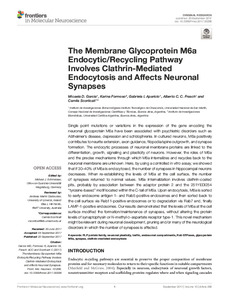Por favor, use este identificador para citar o enlazar este ítem:
https://repositorio.uca.edu.ar/handle/123456789/8671| Título: | The membrane glycoprotein M6a endocytic/recycling pathway involves clathrin-nediated endocytosis and affects neuronal synapses | Autor: | García, Micaela D. Formoso, Karina Aparicio, Gabriela I. Frasch, Alberto C. C. Scorticati, Camila |
Palabras clave: | NEURONAS; PROTEINAS; SINAPSIS; ENDOCITOSIS; PLASTICIDAD | Fecha de publicación: | 2017 | Editorial: | Frontiers | Cita: | Garcia MD, Formoso K, Aparicio GI, Frasch ACC, Scorticati C. The Membrane Glycoprotein M6a Endocytic/Recycling Pathway Involves Clathrin-Mediated Endocytosis and Affects Neuronal Synapses [en línea]. Frontiers in Molecular Neurosciencie 2017;10. doi:10.3389/fnmol.2017.00296 Disponible en: https://repositorio.uca.edu.ar/handle/123456789/8671 | Resumen: | Abstract: Single point mutations or variations in the expression of the gene encoding the neuronal glycoprotein M6a have been associated with psychiatric disorders such as Alzheimer's disease, depression and schizophrenia. In cultured neurons, M6a positively contributes to neurite extension, axon guidance, filopodia/spine outgrowth, and synapse formation. The endocytic processes of neuronal membrane proteins are linked to the differentiation, growth, signaling and plasticity of neurons. However, the roles of M6a and the precise mechanisms through which M6a internalizes and recycles back to the neuronal membrane are unknown. Here, by using a controlled in vitro assay, we showed that if 30-40% of M6a is endocytosed, the number of synapses in hippocampal neurons decreases. When re-establishing the levels of M6a at the cell surface, the number of synapses returned to normal values. M6a internalization involves clathrin-coated pits, probably by association between the adaptor protein 2 and the 251YEDI254 "tyrosine-based" motif located within the C-tail of M6a. Upon endocytosis, M6a is sorted to early endosome antigen 1- and Rab5-positive endosomes and then sorted back to the cell surface via Rab11-positive endosomes or to degradation via Rab7 and, finally LAMP-1-positive endosomes. Our results demonstrated that the levels of M6a at the cell surface modified the formation/maintenance of synapses, without altering the protein levels of synaptophysin or N-methyl-D-aspartate receptor type-1. This novel mechanism might be relevant during neuronal development, pruning and/or many of the neurological disorders in which the number of synapses is affected. | URI: | https://repositorio.uca.edu.ar/handle/123456789/8671 | ISSN: | 1662-5099 | Disciplina: | MEDICINA | DOI: | 10.3389/fnmol.2017.00296 | Derechos: | Acceso Abierto | Fuente: | Frontiers in Molecular Neurosciencie 2017;10 |
| Aparece en las colecciones: | Artículos |
Ficheros en este ítem:
| Fichero | Descripción | Tamaño | Formato | |
|---|---|---|---|---|
| the-membrane-glycoprotein-m6a.pdf | 6,37 MB | Adobe PDF |  Visualizar/Abrir |
Visualizaciones de página(s)
115
comprobado en 30-abr-2024
Descarga(s)
127
comprobado en 30-abr-2024
Google ScholarTM
Ver en Google Scholar
Altmetric
Altmetric
Este ítem está sujeto a una Licencia Creative Commons

